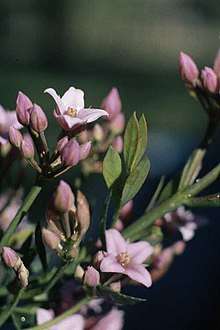Boronia spathulata
Boronia spathulata is a plant in the citrus family, Rutaceae and is endemic to the south-west of Western Australia. It is a glabrous shrub with well-spaced, simple, egg-shaped to elliptic leaves, and pink, four-petalled flowers.
| Boronia spathulata | |
|---|---|
 | |
| Scientific classification | |
| Kingdom: | Plantae |
| Clade: | Tracheophytes |
| Clade: | Angiosperms |
| Clade: | Eudicots |
| Clade: | Rosids |
| Order: | Sapindales |
| Family: | Rutaceae |
| Genus: | Boronia |
| Species: | B. spathulata |
| Binomial name | |
| Boronia spathulata | |
 | |
| Occurrence data from Australasian Virtual Herbarium | |
Description
Boronia spathulata is a glabrous shrub that grows to a height of about 1 m (3 ft 3 in) and has well-spaced, narrow elliptic to broadly egg-shaped leaves that are 10–20 mm (0.39–0.79 in) long. Leaves near the ends of the branchlets are usually more or less cylindrical. The flowers are arranged in cymes that have a short peduncle, the individual flowers on a red pedicel that has small bracts at its base. The side flowers have a pedicel 3–4 mm (0.12–0.16 in) long. There are four triangular to egg-shaped sepals 2.5–4 mm (0.1–0.2 in) long and four pink, egg-shaped petals 6–9 mm (0.2–0.4 in) long. The eight stamens are hairy with a small white tip on the anther and the stigma is only slightly larger than the style. Flowers are present in most months.[2][3]
Taxonomy and naming
Boronia spathulata was first formally described in 1839 by John Lindley and the description was published in A Sketch of the Vegetation of the Swan River Colony.[4][5] The specific epithet (spathulata) is derived from the Latin word spathe meaning "any broad blade, paddle for stirring and mixing".[6]
Distribution and habitat
This boronia grows in sand near swamps or rivers and in jarrah forest. It occurs between Perth and Augusta and east to Israelite Bay.[2][3][7]
Conservation
Boronia spathulata is classified as "not threatened" by the Western Australian Government Department of Parks and Wildlife.[3]
References
- "Boronia spathulata". Australian Plant Census. Retrieved 1 May 2019.
- Duretto, Marco F.; Wilson, Paul G.; Ladiges, Pauline Y. "Boronia spathulata". Flora of Australia: Australian Biological Resources Study, Department of the Environment and Energy, Canberra. Retrieved 1 May 2019.
- "Boronia spathulata". FloraBase. Western Australian Government Department of Parks and Wildlife.
- "Boronia spathulata". APNI. Retrieved 1 May 2019.
- Lindley, John (1839). A Sketch of the Vegetation of the Swan River Colony. London: James Ridgway. p. xvii. Retrieved 1 May 2019.
- Brown, Roland Wilbur (1956). The Composition of Scientific Words. Washington, D.C.: Smithsonian Institution Press. p. 732.
- Corrick, Margaret G.; Fuhrer, Bruce A. (2009). Wildflowers of southern Western Australia (3rd ed.). Dural: Rosenberg Publishing. p. 192. ISBN 9781877058844.